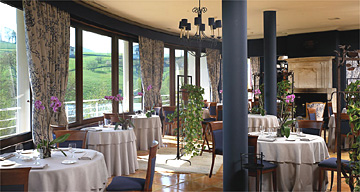
Telephone: +34 943 366471
Address: 4 Loidi Kalea, 20160 Lasarte, Gipuzkoa, Spain
Website: martinberasategui.com
Restaurant Martin Berasategui is a three Michelin-starred restaurant near San Sebastián in the Basque Country in the north of Spain. This relatively small region has a higher ratio of Michelin stars per capita than Paris, and Berasategui was one of the earliest.
The first thing we thought when we arrived was, "Sh1t!" Horse-sh1t, to be precise. The view from the terrace where we sat was stunning, as the countryside of Gipuzkoa is mountainous and lush in vegetation, but the smell was rather noxious. That's nature, though, and after a while you stop noticing it. The terrace was very comfortable and eating outside is always a pleasure, but some of the furnishings were a bit naff: think Californian nouveau riche.
We all went for the tasting menu as it seemed to offer the most interesting dishes. This may sound obvious, but many such menus are designed to make life easier on the kitchen as opposed to highlighting their skills. Appetisers were good, noticeably a refreshing melon jelly and sorbet spiked with mint and onion. We then had the foie gras, smoked eel and apple terrine, which, like the one at Maze (which they serve with rhubarb to fool everyone), tasted like a bratwurst.
The dishes that followed were, in general, over-complicated, lacking focus and overdosed with foams and jelly. Spain may currently be at the forefront of top-end creative cooking, but this is not consubstantial with quality. And if such ambitious dishes as "Octopus in four textures with a spider crab juice, octopus juice bubble, paprika foam and ice herbs" don't deliver, their pretentiousness will stand out like horse manure on a summer's night. Other flops were an over-seasoned Swiss chard juice with truffle jelly, red cabbage jelly, shiso, and a frozen cheese and paprika air (that's all one dish by the way), a dish so confused it's still in counselling, and an almond fondant dessert that just tasted of egg yolks.
On the plus side, I tried goose barnacles, or percebes, for the first time. These were a funky-looking delicacy with a taste lying somewhere between squid and oyster; they were served with fresh peas in a light vegetable broth, a dish that was clean, flavoursome and simple. Also good was the squid ink ravioli in its own consomméé. The waitress told us to bite into the ravioli "so it explodes in your mouth", but she didn't say whether to spit or swallow. What is the protocol these days?
Service was typical of many such three-star establishments: efficient, discreet, and slightly impersonal. The sommelier was the man, though. An old pro, he chose our wines, clearly clocking us from the start, all of them were under 50 euros. The white in particular, a 2005 Jose Pariente Varietal Verdejo, was stunning: crisp, chilled, with a passion fruit aftertaste. The red, a 2002 Finca la Estacada, was pretty good too. I told him it smelt like bananas; he told me I was bananas. It's refreshing to get a bit of banter in these places. It was at this point, after about four glasses, that I realised I was the member of the group driving. Nevermind, I'll just blend right in with all the other Spanish drivers on the road.
Martin Berasategui himself came into the dining room and did a tour of the tables. It's to his credit that he still puts in the hours in the kitchen as he now has a restaurant group profitable enough to negate this. He had a spark in his eye and talked with passion, enthusiasm and honesty. I don't take pleasure in criticising restaurants and would much rather write good reviews over bad ones. He seems like a really good guy, but I'm sorry, the meal was poor. We left disappointed, full, but €170 lighter.

